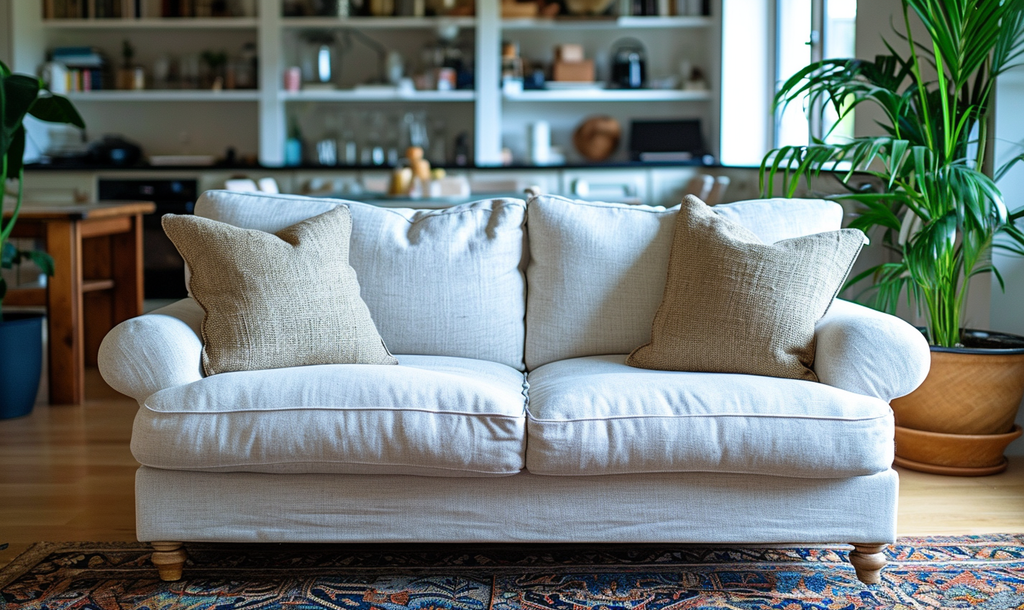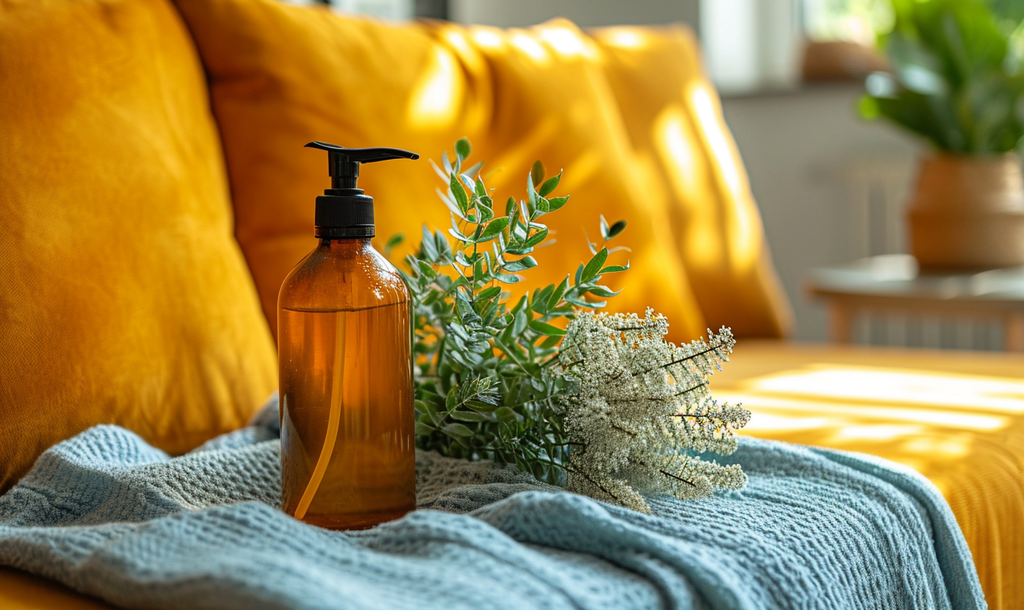Introduction:
A pristine sofa is not merely a piece of furniture; it's a reflection of your dedication to creating a home that is both inviting and healthy. The importance of maintaining a clean sofa goes beyond aesthetics, impacting the overall ambiance of your living space. As we delve into the nuances of sofa cleaning, it becomes apparent that understanding your sofa's fabric is the cornerstone of effective care. From identifying fabric types to decoding cleaning codes, this guide is a comprehensive manual for anyone seeking to elevate their home care routine.
Beyond the superficial allure, our sofas play a crucial role in our daily lives, witnessing laughter, relaxation, and shared moments. Therefore, it becomes imperative to treat them with the care they deserve. This guide transcends the ordinary, offering insights into DIY techniques that go beyond the conventional, making sofa cleaning an empowering and budget-friendly endeavor. From homemade fabric cleaners to preventative measures against future stains, these tips ensure that your sofa remains a haven of comfort.

The First Step to Effective Cleaning
Your sofa, a central piece of furniture in your home, comes in various fabrics, each requiring a specific approach to cleaning for optimal maintenance. In this comprehensive exploration, we will delve into the intricacies of understanding your sofa fabric, which serves as the foundation for effective cleaning practices.
1. Identifying the Sofa Fabric:
The first step in sofa care is identifying the fabric it's made of. Common fabrics include linen, leather, microfiber, and more. The identification process is facilitated by checking the manufacturer's labels, typically found under cushions or on the base. These labels provide valuable information about the fabric composition and recommended cleaning methods.
Understanding the specific fabric is crucial because different materials react differently to cleaning agents and techniques. For instance, a spill on a leather sofa requires a different approach than one on a microfiber sofa. Take note of any unique characteristics of the fabric, such as sensitivity to moisture, colorfastness, or potential for shrinkage.

2. Decoding Cleaning Codes:
Once you've identified the sofa fabric, the next step is decoding the cleaning codes. These codes, often represented by letters, provide guidance on the recommended cleaning methods. The four main cleaning codes are:
W (Water): Water-based cleaning methods are safe.
S (Solvent): Only solvent-based cleaners are recommended.
WS (Water/Solvent): Both water-based and solvent-based cleaners are suitable.
X (No water or solvent): Vacuum only; avoid using water or solvents.
Understanding these codes is pivotal, as using the wrong cleaning method can lead to damage. For example, using water on a sofa labeled "S" can result in water stains or discoloration. Take the time to familiarize yourself with the cleaning codes specific to your sofa fabric.

3. Pre-testing on an Inconspicuous Area:
Before embarking on a comprehensive cleaning journey, it's advisable to perform a pre-test on an inconspicuous area of the sofa. This small, hidden spot allows you to assess how the fabric reacts to your chosen cleaning solution without risking visible damage. This precautionary step is particularly crucial for sensitive fabrics, ensuring that your cleaning method is safe for the entire sofa.
Performing a pre-test involves applying a small amount of the chosen cleaning solution to the hidden area and observing for any adverse reactions, such as color fading or texture changes. If the fabric responds well, you can proceed with confidence in cleaning the entire sofa.
4. General Maintenance Tips for All Fabric Types:
Regardless of the specific fabric, some general maintenance tips apply universally:
Regular Vacuuming: Dust, dirt, and debris can accumulate on any sofa. Regular vacuuming with an upholstery attachment helps prevent particles from embedding into the fabric.
Flipping and Rotating Cushions: Evenly distribute wear and tear by periodically flipping and rotating cushions. This simple practice ensures that one side of the sofa doesn't degrade faster than the others.
Taking these general maintenance steps into consideration establishes a foundation for a well-maintained sofa, regardless of the fabric type. By incorporating these practices into your routine, you contribute to the overall longevity and cleanliness of your sofa.
Understanding your sofa fabric sets the stage for effective and safe cleaning. Whether you have a luxurious leather sofa or a cozy microfiber one, each fabric type demands a tailored approach. By decoding cleaning codes, conducting pre-tests, and implementing general maintenance, you equip yourself with the knowledge needed to preserve the beauty and integrity of your sofa for years to come.

DIY Sofa Cleaning Techniques for a Budget-Friendly Refresh
Revitalizing your sofa on a budget is not only achievable but also empowering with these DIY cleaning techniques. Tailored to various fabric types, these methods ensure both affordability and effectiveness, giving your sofa a budget-friendly refresh.

1. Homemade Fabric Cleaner Recipes:
Crafting your own fabric cleaner allows for customization based on your sofa's fabric. For microfiber sofas, a mixture of equal parts white vinegar and rubbing alcohol with a few drops of essential oil works wonders. Linen or cotton sofas benefit from a solution of mild dish soap and lukewarm water, while leather sofas can be gently wiped with a mixture of equal parts water and white vinegar.
2. Steam Cleaning at Home:
A DIY steam cleaning alternative using common household items delivers a deep cleanse. Sprinkle baking soda generously on the sofa, then apply a mixture of equal parts vinegar and water using a spray bottle. The fizzing action lifts stains, and a soft brush or cloth helps agitate the mixture. Wipe away residue with a clean, damp cloth, leaving your sofa refreshed and odor-free.
3. Removing Stains Naturally:
Natural ingredients are powerful allies in stain removal. For coffee stains, a mixture of water and vinegar effectively tackles the blemish. Wine stains surrender to a combination of salt, dish soap, and hydrogen peroxide, while rubbing alcohol proves effective for ink stains. These natural solutions not only remove stains but also spare you the expense of commercial stain removers.
4. Deodorizing Your Sofa:
A fresh-smelling sofa contributes to a pleasant living space. A DIY deodorizing method involves sprinkling baking soda generously on the sofa, optionally mixing in a few drops of essential oil for fragrance. Let it sit for at least 15 minutes, then vacuum thoroughly to remove both odors and baking soda residue.
Embrace these DIY sofa cleaning techniques to breathe new life into your furniture without straining your budget. From homemade fabric cleaners to natural stain removers and deodorizing methods, these techniques offer a personalized and cost-effective approach to sofa care. Rediscover the joy of a refreshed and inviting sofa without breaking the bank, empowering you to take control of your home's cleanliness.
When to Seek Expert Help
While DIY methods work wonders for routine sofa maintenance, there are instances when seeking professional sofa cleaning services becomes essential for a thorough and effective refresh. Understanding when to enlist expert help ensures that your sofa receives the specialized care it deserves.

1. Signs Your Sofa Needs Professional Cleaning:
Recognizing the signs that your sofa requires professional attention is the first step in maintaining its longevity and appearance. Persistent stains that resist DIY treatments, lingering odors that persist despite your efforts, or noticeable fabric damage are clear indicators that professional intervention is necessary. These signs signal that the accumulated dirt, grime, and contaminants have reached a point where specialized equipment and expertise are needed for a comprehensive clean.

2. Choosing the Right Professional Cleaner:
Selecting the right professional cleaner is crucial for the success of the cleaning process. Researching and vetting cleaning services ensure that you entrust your sofa to capable hands. Look for companies with positive reviews and testimonials, and inquire about their experience in dealing with various fabric types. A reputable cleaner will be transparent about their methods, pricing, and potential outcomes, giving you confidence in their ability to restore your sofa to its optimal condition.
3. Preparing Your Sofa for Professional Cleaning:
Before the professionals arrive, taking a few preparatory steps ensures a smooth and efficient cleaning process:

4. Clear the Space:
Remove any obstacles around the sofa, providing the cleaners with ample room to work.
5. Communicate Specific Concerns:
Inform the cleaning professionals about any specific concerns you have regarding stains, odors, or delicate areas. This open communication allows them to tailor their approach to address your sofa's unique needs.
Aftercare Tips for Maintaining Professional Cleaning Results:
Once your sofa receives professional cleaning, implementing proper aftercare measures is essential for maintaining the results:
6. Avoid Immediate Use:
Allow the sofa to dry completely before using it again. Using the sofa while it's still damp can compromise the effectiveness of the cleaning and may lead to new stains.
Implement a Regular Maintenance Routine: Consider establishing a regular maintenance routine to prevent the buildup of dirt and stains. This could include routine vacuuming, prompt cleaning of spills, and periodic spot checks.
7. Understanding Costs and Budgeting:
While professional sofa cleaning services come at a cost, viewing it as an investment in the longevity and appearance of your furniture reframes the expense. The cost of professional cleaning varies based on factors such as the size of the sofa, fabric type, and the extent of cleaning required. However, it's essential to consider it as a proactive measure to protect your valuable furniture, potentially saving you money on repairs or replacements in the long run.
In conclusion, professional sofa cleaning services offer a specialized and effective solution for addressing stubborn stains, deep-seated dirt, and fabric damage. Knowing when to seek expert help, choosing the right professional cleaner, and implementing proper aftercare measures ensures that your sofa receives the care it deserves. While the cost may be a consideration, the benefits of a rejuvenated and well-maintained sofa make it a worthwhile investment in the overall comfort and aesthetics of your living space.
FAQs: Addressing Common Sofa Cleaning Concerns
Can I use the same cleaning method for all types of sofa fabrics?
No, different fabrics require different cleaning approaches. While some fabrics may withstand water-based cleaning methods, others might be damaged by moisture. Always refer to the manufacturer's cleaning codes and tailor your cleaning method accordingly.
How often should I clean my sofa?
The frequency of sofa cleaning depends on factors like usage, household environment, and the presence of pets or children. As a general rule, aim for regular maintenance, including vacuuming and spot cleaning, with a deeper clean every 6-12 months.
Is it safe to use commercial upholstery cleaners?
Commercial cleaners can be effective, but it's crucial to choose products suitable for your sofa's fabric and follow the instructions carefully. Test the cleaner on a small, inconspicuous area first to ensure it doesn't cause any damage or discoloration.
Can I machine wash sofa cushion covers?
Check the care instructions on your cushion covers. If they are labeled as machine-washable, follow the guidelines provided. Use a gentle cycle, mild detergent, and avoid high heat during drying to prevent shrinkage or damage to the fabric.
What should I do if my sofa fabric has a "Dry Clean Only" label?
If your sofa has a "Dry Clean Only" label, it's essential to follow this recommendation. Professional dry cleaning ensures that the fabric is cleaned without the risk of water damage. Attempting to clean it with water may lead to shrinking or color bleeding.
These FAQs address common concerns about sofa cleaning, providing insights to help you navigate the nuances of maintaining different types of sofas. Always prioritize caution, conduct tests before applying new cleaning methods, and consider seeking professional advice for specific or challenging situations. With the right knowledge and approach, you can ensure that your sofa remains a clean and inviting centerpiece in your home for years to come.
Conclusion:
As we wrap up this exploration into the world of sofa cleaning, it's clear that the journey to a spotless living room is a commitment to the well-being of your home. Your sofa, a silent witness to countless moments, deserves meticulous care. Understanding your sofa's fabric and cleaning codes empowers you to be a steward of its longevity, while pre-testing on an inconspicuous area prevents irreversible damage. General maintenance tips, such as regular vacuuming and cushion rotation, are gestures of affection towards a piece of furniture that holds a special place in your daily life.
Moving on to DIY techniques, homemade fabric cleaner recipes and steam cleaning at home provide a hands-on approach to sofa care. Removing stains naturally and deodorizing techniques transform accidents into opportunities for restoration, adding a layer of freshness and comfort to your sofa.
Professional sofa cleaning services are a strategic move for optimal care. Identifying signs that your sofa needs professional attention ensures timely intervention. Choosing the right professional cleaner is crucial, and aftercare tips underscore the significance of a delicate convalescence period for your sofa.
Considering the financial aspect and budgeting for professional cleaning, view it as an investment in the longevity of your furniture. Your sofa is a valuable asset, and safeguarding its structural integrity pays dividends in the long run.

Call to Action :
1. Embrace Regular Maintenance as a Lifestyle:
Upholding the cleanliness of your sofa should not be a sporadic effort but rather an integral part of your lifestyle. Incorporate simple routines into your daily life, such as quick vacuum sessions or occasional spot cleaning. Small, consistent efforts accumulate over time, ensuring that your sofa maintains its allure without requiring drastic interventions.
2. Join the Community of Home Care Enthusiasts:
The journey to a spotless sofa is not a solitary one. Join online communities, forums, or social media groups where home care enthusiasts share insights, experiences, and innovative solutions. Engaging in discussions with like-minded individuals can unveil hidden gems of wisdom and foster a sense of camaraderie. You're not alone on this quest for a clean and inviting living space.
3. Explore Sustainable and Eco-Friendly Options:
In the pursuit of a clean sofa, consider the environmental impact of your choices. Explore sustainable and eco-friendly cleaning options that not only benefit your home but also contribute to a greener planet. From choosing biodegradable cleaning agents to repurposing old linens for DIY cleaning solutions, every eco-conscious decision adds to the well-being of both your living space and the Earth.
Embarking on this journey towards a cleaner sofa is not just about the destination; it's about the lifestyle you adopt along the way. Transform your home care routine into a fulfilling and sustainable practice, ensuring that your living space becomes a sanctuary of comfort, hygiene, and lasting beauty. Your sofa is more than furniture; it's a canvas for the memories you create. Uphold its essence by embracing a holistic approach to cleaning and maintenance.














